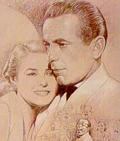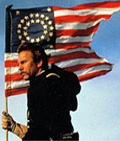|
Study Guide -
High Noon (1952)
Director : Fred Zinnerman
Stars :
Gary Cooper .... Marshal Will Kane
Thomas Mitchell .... Mayor Jonas Henderson
Lloyd Bridges .... Deputy Sheriff Harvey Pell
Katy Jurado .... Helen Ramírez
Grace Kelly .... Amy (Fowler) Kane
Harry Morgan .... Sam Fuller
Ian MacDonald .... Frank Miller
Preparation :
Read the movie reviews by Filmsite.org, Robert Beradinelli and the New York Times
Historical/Social Significance :
"Carl Forman (the writer) saw High Noon as an allegory about his own persecution during the McCarthy era".1
"Zinnerman score two bull's-eyes for historical accuracy : for many years , Western towns had to defend themselves against outlawry (no FBI or state troopers to help), and - like Will Kane - local lawmen occasionally found themselves fresh out of friends when trouble rode into town".2
Synopsis :
Will Kane is looking forward to taking a honeymoon with his new wife. As he prepares to leave he learns that Frank Miller, who once terrorized the town has been released from prison and is heading to town looking for revenge.
Guided Questions for Viewing :
Assessment questions will be based on the following :
-
Carl Forman (the writer) saw High Noon as an allegory about his own persecution during the McCarthy era. He was called to Washington and when he refused to testify against his friends he was blacklisted. Many people who were called before the committee were more interested in their own self preservation than in standing up to the HUAC. Comment on this with regards to the film.
-
Will Kane sticks to his principles but he only survived because his wife was forced to abandon hers. Comment on this statement with reference to the movie.
-
The theme of the McCarthy hearing runs through this movie and The Crucible. Discuss the statements the two movies make about the hearings.
-
"The issue of moral responsibility, is what makes High Noon unique among Westerns and raises the question, is civilization really worth fighting for?"3 Compare and contrast the judge's actions (who folds his American flag and places it in his saddlebag before fleeing) and those of Will Kane in light of America's policy in Viet Nam and/or Korea and/or now in Iraq.
-
The director uses some interesting devices from a film making point of view. Comment on the use of the clocks, the railroad tracks and the black and white cinematography
- "High Noon, in its attack on the timidity of the respectable majority and its contempt for the think-alike, act-alike mentality, is clearly about the American social climate of 1952." Gerald Mast A Short History of the Movies
Comment on this statement.
-
Some people have analyzed High Noon as a parable about democracy vs. fascism. Some of the townspeople seem ready to accept "fascist" rule if it will mean better economic times. Comment on this with examples from the movie.
Sources:
1. "Behind the Scenes of High Noon" High Noon DVD 2002
2. Roquemore, Joseph. History Goes to the Movies 1999. p. 104.
www.filmsite.org/high.html
3. McGee, Scott and Stafford, Jeff. High Noon (1952). www.turnerclassicmovies.com
www.teachwithmovies.com.CMP/guides/high-noon.html
|



